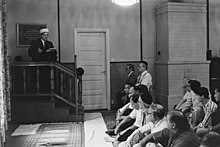
Back التتار الفنلنديين ARZ Фінскія татары Byelorussian Finští Tataři Czech Finnland-Tataren German تاتارهای فنلاند Persian Suomen tataarit Finnish Finlandstatarer NB Татары в Финляндии Russian Финскэй Татаардар SAH Finländska tatarer Swedish
 Imam Enver Yıldırım and Finnish Tatars during a prayer service at the Järvenpää Mosque in 1989. | |
| Total population | |
| Helsinki, Tampere, Turku, Järvenpää | |
| Languages | |
| Tatar (Mishar dialect), Finnish | |
| Religion | |
| Sunni Islam | |
| Related ethnic groups | |
| Mishar Tatars and other Volga Tatars |
The Finnish Tatars (Tatar: Финляндия татарлары, romanized: Finləndiyə tatarları, Finnish Tatar: Finlandiya tatarları, Finnish: Suomen tataarit) are a Tatar ethnic group and minority in Finland, consisting of approximately 600–700 members. The community was formed between the late 1800s and the early 1900s, when Mishar Tatar merchants emigrated from the Nizhny Novgorod Governorate of the Russian Empire, and eventually settled in Finland. Tatars have the main building of their congregation in Helsinki. They have also founded cultural associations in different cities. They are the oldest Muslim community in Finland.
The identity of the Finnish Tatars has had different reference points throughout their history. In the early days, they were known by their religious identity (Muslims). When Republic of Turkey was established, local Turkic Tatars began associating themselves as "Turks"[a]. They were influenced by Turkish culture, and for example adopted the Latin alphabet, which replaced the previously used Arabic one. Nowadays, Finnish Tatars once again identify as Tatars and are very connected to Tatarstan. Its head, Rustam Minnikhanov, has visited the community.
Finnish Tatars have also maintained their connections to Turkey however. Erdoğan, among others, has visited their congregation. In 2024, a Finnish Tatar history book, translated in to Turkish and written by a doctor of philosophy, imam of the Tatar congregation Ramil Belyaev, was released in Ankara [1][2].
Cite error: There are <ref group=lower-alpha> tags or {{efn}} templates on this page, but the references will not show without a {{reflist|group=lower-alpha}} template or {{notelist}} template (see the help page).
- ^ Беляев, Рамиль: Татары Финляндии – история, интеграция, сохраненне идентичности. Казань, 2019. ISBN 978-5-6043753-3-4
- ^ "Finlandiya Tatarları Kitabı Finlandiya Cumhurbaşkanı Stubb'ın Katılımıyla YTB'de Tanıtıldı".